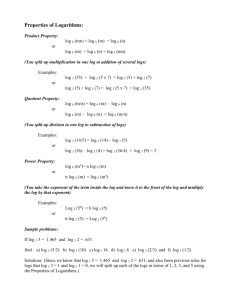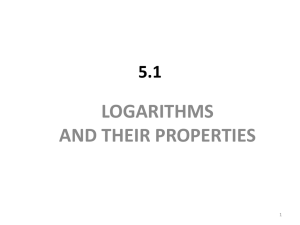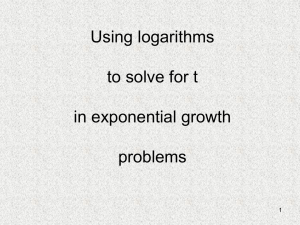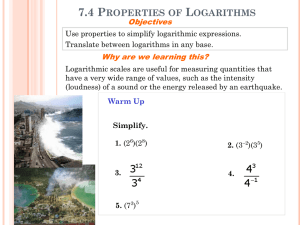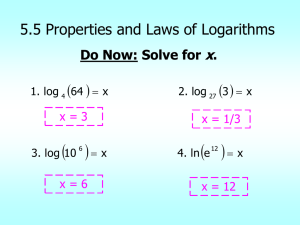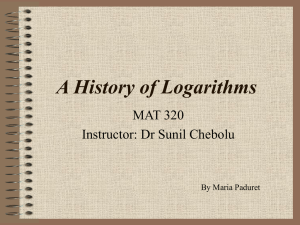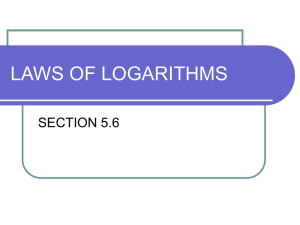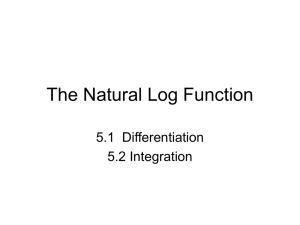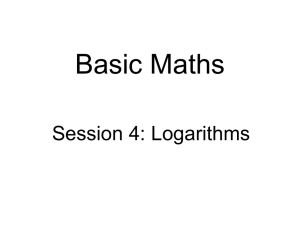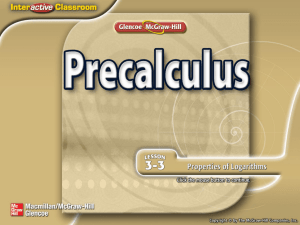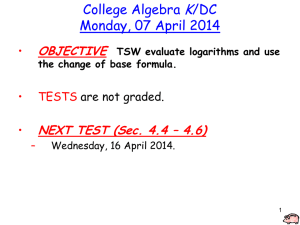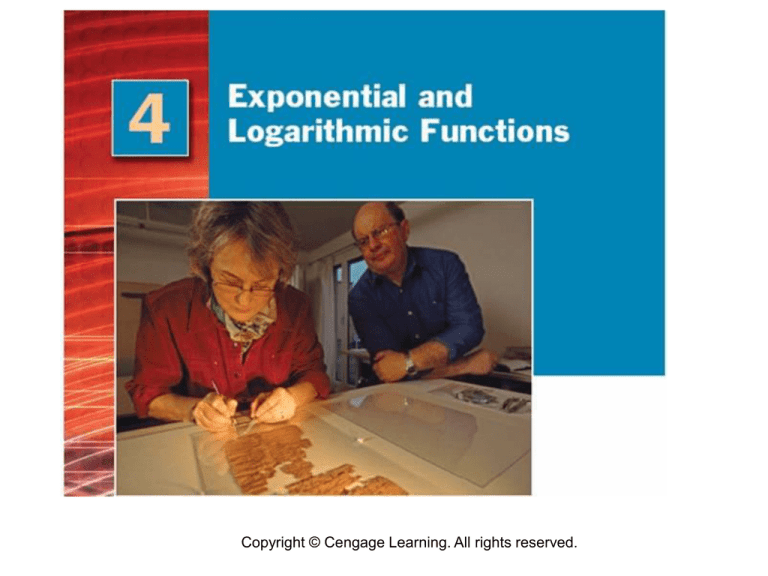
Copyright © Cengage Learning. All rights reserved.
4.2
LOGARITHMIC FUNCTIONS
Copyright © Cengage Learning. All rights reserved.
Introduction
3
Introduction
In this section we introduce logarithmic functions,
emphasizing the natural logarithm function.
We then apply natural logarithms to a wide variety of
problems, from doubling money under compound
interest to drug dosage.
4
Logarithms
5
Logarithms
The word logarithm (abbreviated log) means power or
exponent.
The number being raised to the power is called the base
and is written as a subscript.
For example, the expression log10 1000 means the
exponent to which we raise 10 to get 1000.
Since 103 = 1000, the exponent is 3, so the logarithm
is 3:
log10 1000 = 3
since 103 = 1000
We find logarithms by writing them as exponents and
then finding the exponent.
6
Example 1 – FINDING A LOGARITHM
Evaluate log10 100.
Solution:
Therefore
log10100 = 2
since 102 = 100
7
Logarithms
Logarithms to the base 10 are called common logarithms
and are often written without the base, so that log100
means log10 100.
We may find logarithms to other bases as well. Any positive
number other than 1 may be used as a base.
In general, for any positive base a other than 1,
8
Natural Logarithms
9
Natural Logarithms
The most widely used of all bases is e, the number
(approximately 2.718).
Logarithms to the base e are called natural logarithms or
Napierian logarithms. The natural logarithm of x is written
ln x (“n” for “natural”) instead of loge x.
In words: ln x is the power to which we raise e to get x.
10
Natural Logarithms
The table below shows some values of the natural
logarithm function f(x) = ln x, and its graph (based on these
points) is shown on the right.
11
Natural Logarithms
Notice that the graph of ln x is always increasing and has
the y-axis as a vertical asymptote.
The natural logarithm function may be used for modeling
growth that continually slows.
12
Natural Logarithms
The following graph shows logarithm functions for several
different bases. Notice that each passes through the point
(1, 0), since a0 = 1.
We will concentrate on the natural logarithm function, since
it is the one most used in applications.
13
Natural Logarithms
Since logs are exponents, each property of exponents can
be restated as a property of logarithms.
The first three properties show that some natural
logarithms can be found without using a calculator.
14
Example 4 – USING THE PROPERTIES OF NATURAL LOGARITHMS
15
Natural Logarithms
The next four properties enable us to simplify logs of
products, quotients, and powers.
For positive numbers M and N and any number P:
16
Example 5 – USING THE PROPERTIES OF NATURAL LOGARITHMS
17
Doubling Under Compound Interest
18
Doubling Under Compound Interest
How soon will money invested at compound interest double
in value?
The solution to this question makes important use of the
property ln (MP) = P · ln M (“logs bring down exponents”).
19
Example 9 – FINDING DOUBLING TIME
A sum is invested at 12% interest compounded quarterly.
How soon will it double in value?
Solution:
We use the formula P(1 + r/m)mt with r = 0.12 and m = 4.
Since double P dollars is 2P dollars, we want to solve
20
Example 9 – Solution
cont’d
The variable is in the exponent, so we take logarithms to
bring it down.
A sum at 12% compounded quarterly doubles in about
5.9 years.
21
Carbon 14 Dating
22
Carbon 14 Dating
All living things absorb small amounts of radioactive carbon
14 from the atmosphere.
When they die, the carbon 14 stops being absorbed and
decays exponentially into ordinary carbon.
Therefore, the proportion of carbon 14 still present in a
fossil or other ancient remain can be used to estimate how
old it is.
23
Carbon 14 Dating
The proportion of the original carbon 14 that will be present
after t years is
24
Example 12 – DATING BY CARBON 14
The Dead Sea Scrolls, discovered in a cave near the Dead
Sea in what was then Jordan, are among the earliest
documents of Western civilization. Estimate the age of the
Dead Sea Scrolls if the animal skins on which some were
written contain 78% of their original carbon 14.
Solution:
The proportion of carbon 14 remaining after t years is
e–0.00012t.
25
Example 12 – Solution
cont’d
We equate this formula to the actual proportion (expressed
as a decimal):
e–0.00012t = 0.78
ln e–0.00012t = ln 0.78
–0.00012t = ln 0.78
Equating the proportion
Taking natural logs
ln e–0.00012t = –0.00012t
by Property 3
Solving for t and
using a calculator
Therefore, the Dead Sea Scrolls are approximately 2070
years old.
26
Behavioral Science: Learning
Theory
27
Behavioral Science: Learning Theory
Your ability to do a task generally improves with practice.
Frequently, your skill after t units of practice is given by a
function of the form
S(t) = c(1 – e–kt)
where c and k are positive constants.
28
Example 13 – ESTIMATING LEARNING TIME
After t weeks of training, your secretary can type
S(t) = 100(1 – e–0.25t)
words per minute. How many weeks will he take to reach
80 words per minute?
Solution:
We solve for t in the following equation:
100(1 – e–0.25t) = 80
Setting S(t) equal to 80
1 – e–0.25t = 0.80
Dividing by 100
–e–0.25t = –0.20
Subtracting 1
e–0.25t = 0.20
Multiplying by –1
29
Example 13 – Solution
–0.25t = ln 0.20
cont’d
Taking natural logs
Solving for t
Using a calculator
He will reach 80 words per minute in about
weeks.
30
Social Science: Diffusion of
Information by Mass Media
31
Social Science: Diffusion of Information by Mass Media
When a news bulletin is repeatedly broadcast over radio
and television, the proportion of people who hear the
bulletin within t hours is
p(t) = 1 – e–kt
for some constant k.
32
Example 14 – PREDICTING THE SPREAD OF INFORMATION
A storm warning is broadcast, and the proportion of people
who hear the bulletin within t hours of its first broadcast is
p(t) = 1 – e–0.30t. When will 75% of the people have heard
the bulletin?
Solution:
Equating the proportions gives 1 – e–0.30t = 0.75.
Solving this equation gives t 4.6.
Therefore, it takes about
hear the news.
hours for 75% of the people to
33

